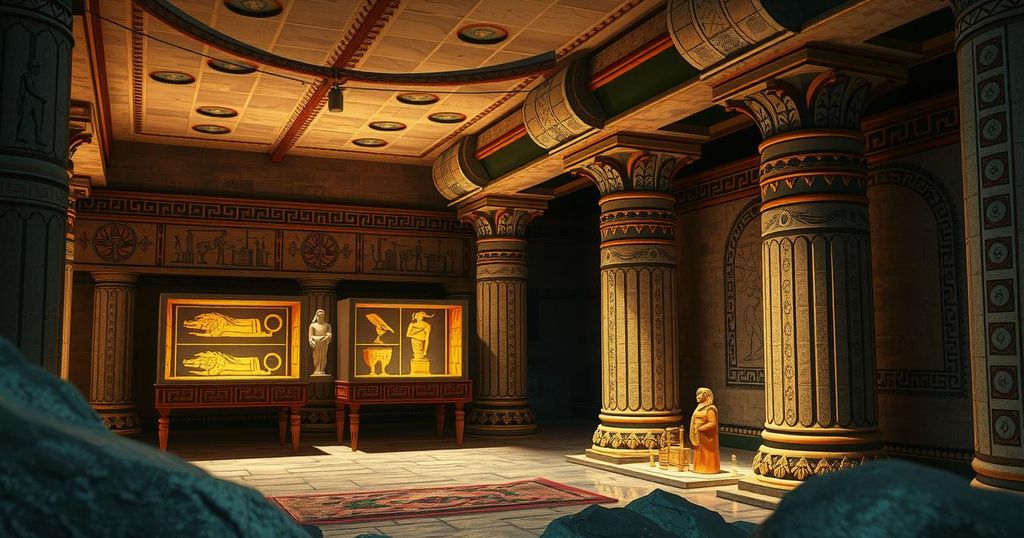Celebrity
AFRICA, ARCHAEOLOGY, BIONDI, EGYPT, ENTERTAINMENT, ENVIRONMENTAL IMPACT, EUROPE, FRANCE, GIZA, GIZA PLATEAU, HISTORY, MALANGA, MO, MOTOYUKI SATO, NUBIA, OF STRATHCLYDE, ROMAN EMPIRE, SCIENCE, SCIENCE WORLD NEWS, TO, TOHOKU UNIVERSITY, UNIVERSITY OF PISA, WORLD NEWS
Jamal Robinson
0 Comments
Mysterious Discoveries Beneath the Giza Pyramids: Implications for History
Recent archaeological discoveries beneath the Giza Pyramids indicate the presence of extensive underground structures and diverse skeletons, suggesting complexities that challenge traditional narratives. Studies using Synthetic Aperture Radar reveal significant formations and anomalies, prompting new theories regarding the pyramids’ purpose beyond merely being tombs. As research progresses, these findings may reshape our understanding of ancient Egyptian history.
The Giza Pyramids have captivated historians, but recent archaeological discoveries hint at hidden complexities that may redefine ancient Egyptian history. New findings have emerged, revealing mysterious underground structures and skeletal remains that challenge established narratives about the pyramids, suggesting they may serve purposes beyond mere tombs. The fusion of advanced technology with innovative theories indicates that the pyramids’ significance goes far beyond conventional understanding.
Recent studies utilizing Synthetic Aperture Radar (SAR) have uncovered planet-wide vertical cylindrical structures 648 meters beneath the Giza Plateau, involving researchers Corrado Malanga from the University of Pisa and Filippo Biondi from the University of Strathclyde. Their work, detailed in a March 15, 2023 press release, identified five identical structures with multiple levels near the Khafre Pyramid. Additionally, eight hollow, spiraling wells link to two large cube-shaped formations, suggesting an extensive underground network extending beneath all three pyramids.
Furthermore, a survey conducted between 2021 and 2023 utilizing ground-penetrating radar revealed an L-shaped structure approximately 6.5 feet deep and deeper anomalies that may be chambers. Motoyuki Sato from Tohoku University emphasizes that L-shaped formations cannot occur naturally. The 2023 Scan Pyramids project further identified a 30-foot corridor, adding to the enigmatic landscape surrounding the pyramids.
In March 2025, skeletons found at the site dated back to 3000 BCE, before the pyramids, and originated from Nubia, challenging the traditional view of the labor force that constructed the pyramids. Osteologist Dr. Sarah Field expressed surprise over these findings, which contradict the prevailing notion of a homogenous local builder workforce.
Traditionally viewed as tombs built around 2500 BCE, the pyramids exhibit mathematical relationships to Pi, the golden ratio, and even the speed of light. These elements, coupled with emerging theories by noted figures like Nikola Tesla, Christopher Dunn, and Joseph Farrell, further complicate their historical narrative, suggesting potential applications in energy generation or ancient technology. The recent discoveries inspire speculation about the pyramids functioning as mysterious power sources.
While the research team seeks excavation permits, the unlikely success may hinder the investigation of essential links between the pyramids, historical resources like the Nile for stone transport, reinforcing the idea that the Giza Pyramids’ story is a fascinating blend of ancient history and speculative science fiction awaiting further exploration.
The recent discoveries beneath the Giza Pyramids present a transformative perspective on ancient Egyptian history, highlighting complex underground structures and diverse skeletal remains that may reshape our understanding of the pyramid builders. The findings challenge traditional narratives, prompting new theories about the pyramids’ functions that extend beyond burial sites, suggesting mysterious technological purposes. As researchers continue their investigations, they may uncover revolutionary insights that redefine historical interpretation.
Original Source: www.marca.com




Post Comment